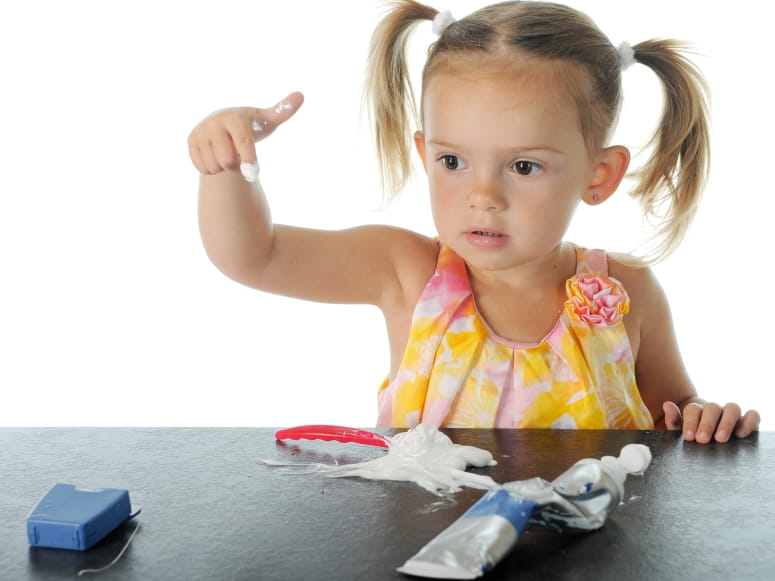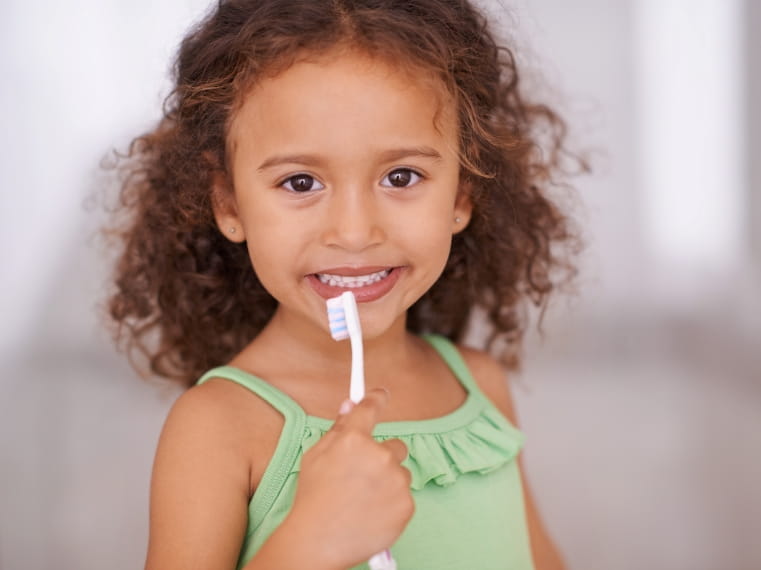My Child Ate Toothpaste: What Should I Do?

The Bottom Line
Toothpaste usually contains fluoride. Swallowing it can cause an upset stomach. Although large amounts of fluoride can be toxic, small unintentional ingestions of over-the-counter, fluoride-containing toothpaste are unlikely to be toxic.

What is toothpaste?
Modern toothpastes come in paste or gel form. They all contain three main ingredients: a mild abrasive (i.e., “grit”) to remove surface stains and debris, a detergent to spread the toothpaste throughout your mouth and wash away debris (this is why toothpaste is foamy), and a flavoring agent. They can also include fluoride to fight cavities, whitening agents, and ingredients to reduce tooth sensitivity.What are toothpaste tablets?
Toothpaste tablets have many of the same ingredients as toothpaste in tubes. You chew the tablet and mix the resulting powder with saliva to form a paste, and then brush as usual. Toothpaste tablets have the advantages of being convenient for travelers and often having recyclable packaging. Their disadvantages include a much higher cost and the absence of long-term studies of their effectiveness compared with regular toothpaste. As with any solid object put into the mouth, a toothpaste tablet could present a choking hazard.When to start brushing baby teeth with toothpaste?
Begin brushing baby teeth as soon as they appear. Use a soft brush and a bit of fluoride-containing toothpaste about the size of a grain of rice. Between the age of 3–6 years, children should be taught how to brush their own teeth using a pea-sized amount of toothpaste twice a day. Some toothpastes are marketed as “training toothpaste” for kids learning to brush their own teeth. Training toothpastes usually do not contain fluoride. The flavoring and the pictures of kids' favorite cartoons on the packaging can make it tempting for kids to eat toothpaste. Training toothpaste is usually sweetened with sorbitol, which can have a mild laxative effect.Does toothpaste expire?
Toothpaste packaging usually shows an expiration date. It is typically on the box and on the crimped end of the tube. An expiration date is the manufacturer’s indication of when an unopened product might begin to lose some of its quality. Expiration dates are very conservative and often have large margins of safety built into them.Why does toothpaste contain fluoride?
Fluoride helps prevent tooth decay by keeping tooth enamel strong and inhibiting the growth of bacteria. Toothpaste contains low concentrations of fluoride—just enough to provide some fluoride during brushing. Many communities add fluoride to their drinking water to help protect teeth, as well as strengthen them while they are being formed.
Some people are especially prone to cavities. Their dentists can order prescription-strength toothpaste with about four times the fluoride concentration of regular toothpaste. If a child eats more than a taste of a prescription-strength toothpaste, use the webPOISONCONTROL online tool to make sure the amount is safe.
What happens if you swallow toothpaste? Is toothpaste poisonous?
When used as directed, toothpaste is not likely to cause symptoms. Toothpaste is not meant to be swallowed, but it happens a lot. A child who has eaten toothpaste is a common reason parents call Poison Control. Kids find the flavors and sweetness of toothpaste irresistible. Often, a child is found sucking the paste out of the tube or is found with the paste smeared all over themselves (and the room!).
When fluoride is in the stomach, it can cause irritation, leading to nausea, vomiting, and diarrhea. The detergent component of toothpaste can have a similar effect. That's why people who eat toothpaste might develop minor gastrointestinal symptoms.
What do I do if a child eats toothpaste?
It is unlikely for a child to have anything beyond a short-term upset stomach from eating over-the-counter toothpaste. In rare cases, if an excessive amount of fluoridated toothpaste is swallowed, there can be more serious problems. Fluoride can lower the amount of calcium and magnesium in the body. This is unlikely to occur from unintentional ingestions by children, especially of over-the-counter toothpaste. Giving the child a snack or beverage containing calcium (e.g., milk, yogurt) will help an upset stomach because calcium binds with fluoride, limiting any potential side effects. Despite being considered safe, toothpaste is still medicine, and should be handled and stored as such.
If you are concerned because someone swallowed toothpaste, or if a prescription-strength toothpaste was eaten, do not make the person vomit. Use the webPOISONCONTROL tool for online guidance or call Poison Control at 1-800-222-1222
Serkalem Mekonnen, RN, BSN, MPH
Certified Specialist in Poison Information
Revised February, 2024 by William G. Troutman, PharmD
Professor of Pharmacy Emeritus
Poison Control Media Information
Did you find this page helpful? If so, we need your support. Poison Control is in constant competition with misinformation online. Links to www.poison.org or our webPOISONCONTROL triage tool from other websites and blogs help internet searchers quickly find accurate information and Poison Control’s contact information in an emergency. If you use the content from this page, please provide attribution via a link back to this page, www.poison.org, or https://triage.webpoisoncontrol.org/#!/exclusions. By doing so, you could save a life. Thank you!
Poisoned?
Call 1-800-222-1222 or
Prevention Tips
- Teach children that toothpaste is medicine.
- Store toothpaste out of reach and sight of children.
- Watch children as they learn to brush their own teeth, reminding them not to swallow the toothpaste.
- For children under 3 years of age, only use a smear or the size of a grain of rice of fluoride toothpaste for brushing, starting when the first tooth appears.
- For children 3–6 years of age, use a pea-sized amount of fluoride toothpaste for brushing.
This Really Happened
A mother of a 3-year-old girl called Poison Control after finding the child with a tube of fluoride-containing toothpaste in the bed with her. The girl was supposed to be napping. It looked like she had eaten some of the toothpaste.
The girl had no symptoms at the time of the call. Poison Control determined that the child would be able to tolerate the amount she might have swallowed. The mother was advised to give the child a calcium-containing snack or beverage and watch for stomach upset. She had some diarrhea a few hours later but did not have any further problems.
For More Information
References
Colgate. What are toothpaste tablets? Updated January 3, 2023. Accessed February 8, 2024.
Martinez A, Im J, Bezman E, et al. A comparison of toothpaste tablets and a sodium fluoride dentifrice for the control of supragingival plaque and gingivitis: A 2-week randomized controlled trial. Am J Dent. 2023;36(4):172-176.
Petrović B, Kojić S, Milić L, et al. Toothpaste ingestion-evaluating the problem and ensuring safety: systematic review and meta-analysis. Front Public Health. 2023;11:1279915. Published 2023 Oct 20.
Recommendations for using fluoride to prevent and control dental caries in the United States. Centers for Disease Control and Prevention. MMWR Recomm Rep. 2001;50(RR-14):1-42.
Walsh T, Worthington HV, Glenny AM, Marinho VC, Jeroncic A. Fluoride toothpastes of different concentrations for preventing dental caries. Cochrane Database Syst Rev. 2019;3(3):CD007868.
Wong MC, Clarkson J, Glenny AM, et al. Cochrane reviews on the benefits/risks of fluoride toothpastes. J Dent Res. 2011;90(5):573-579.
Poisoned?
Call 1-800-222-1222 or
Prevention Tips
- Teach children that toothpaste is medicine.
- Store toothpaste out of reach and sight of children.
- Watch children as they learn to brush their own teeth, reminding them not to swallow the toothpaste.
- For children under 3 years of age, only use a smear or the size of a grain of rice of fluoride toothpaste for brushing, starting when the first tooth appears.
- For children 3–6 years of age, use a pea-sized amount of fluoride toothpaste for brushing.
This Really Happened
A mother of a 3-year-old girl called Poison Control after finding the child with a tube of fluoride-containing toothpaste in the bed with her. The girl was supposed to be napping. It looked like she had eaten some of the toothpaste.
The girl had no symptoms at the time of the call. Poison Control determined that the child would be able to tolerate the amount she might have swallowed. The mother was advised to give the child a calcium-containing snack or beverage and watch for stomach upset. She had some diarrhea a few hours later but did not have any further problems.
